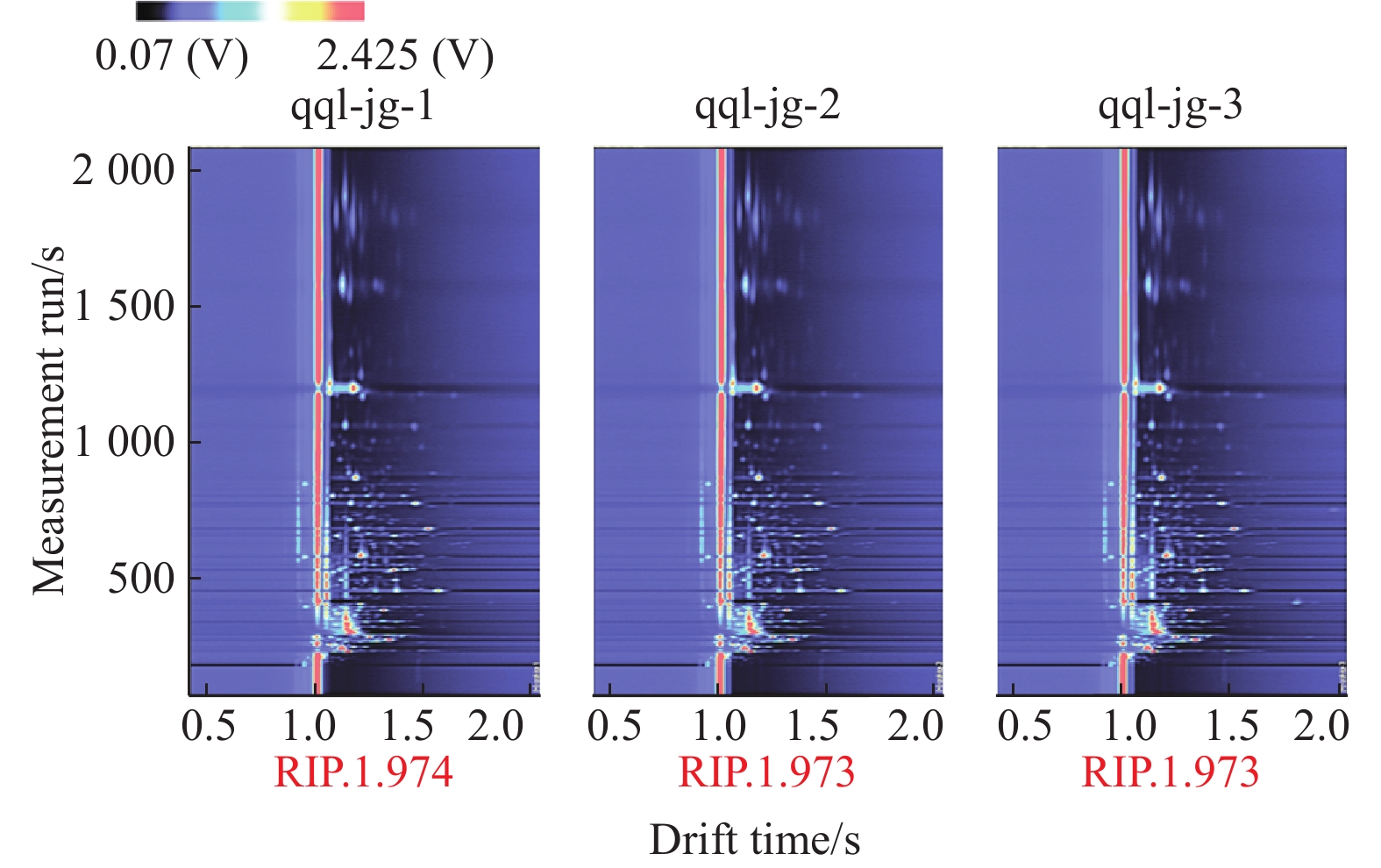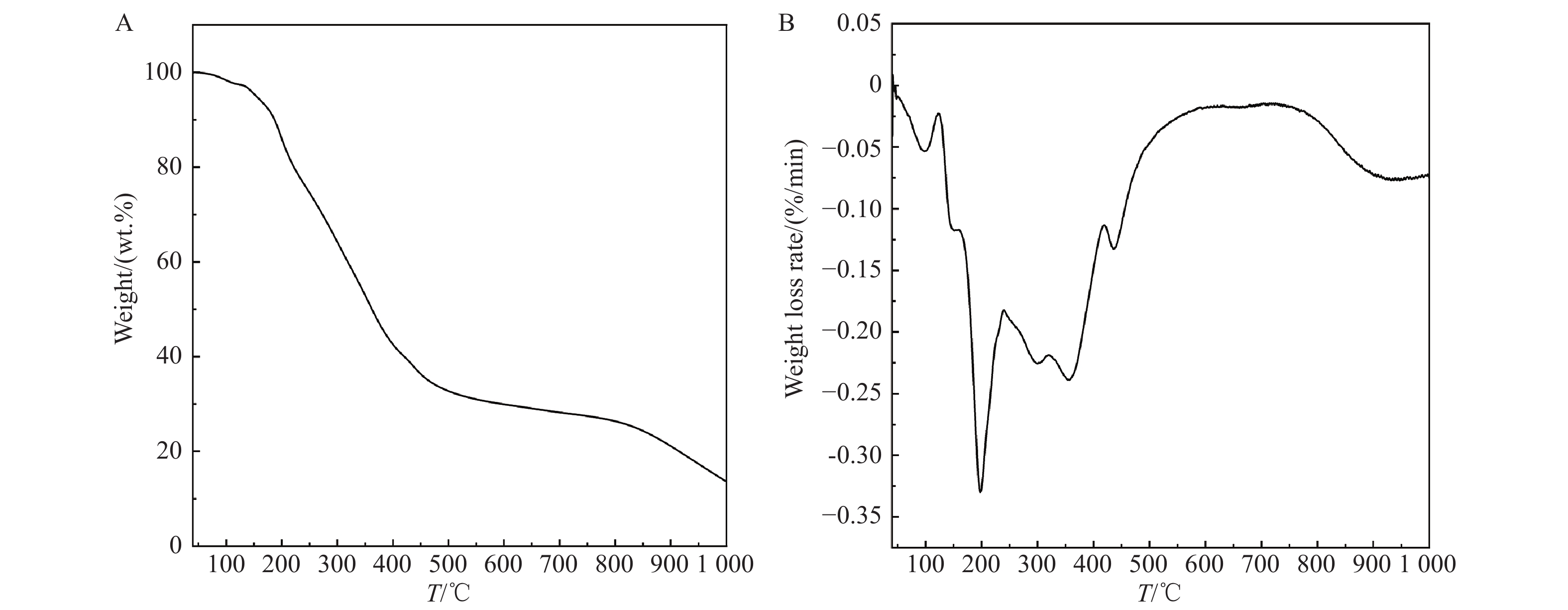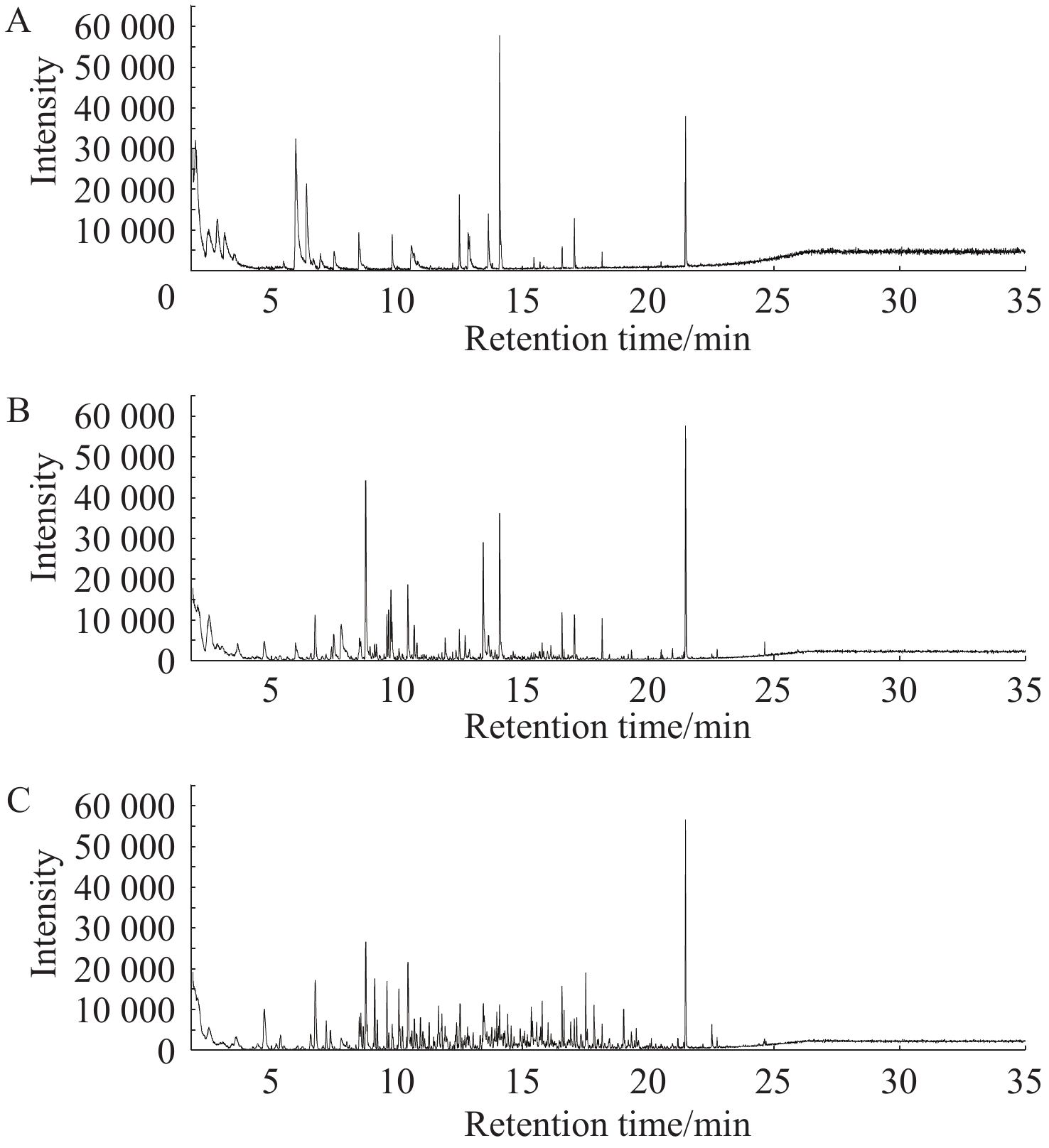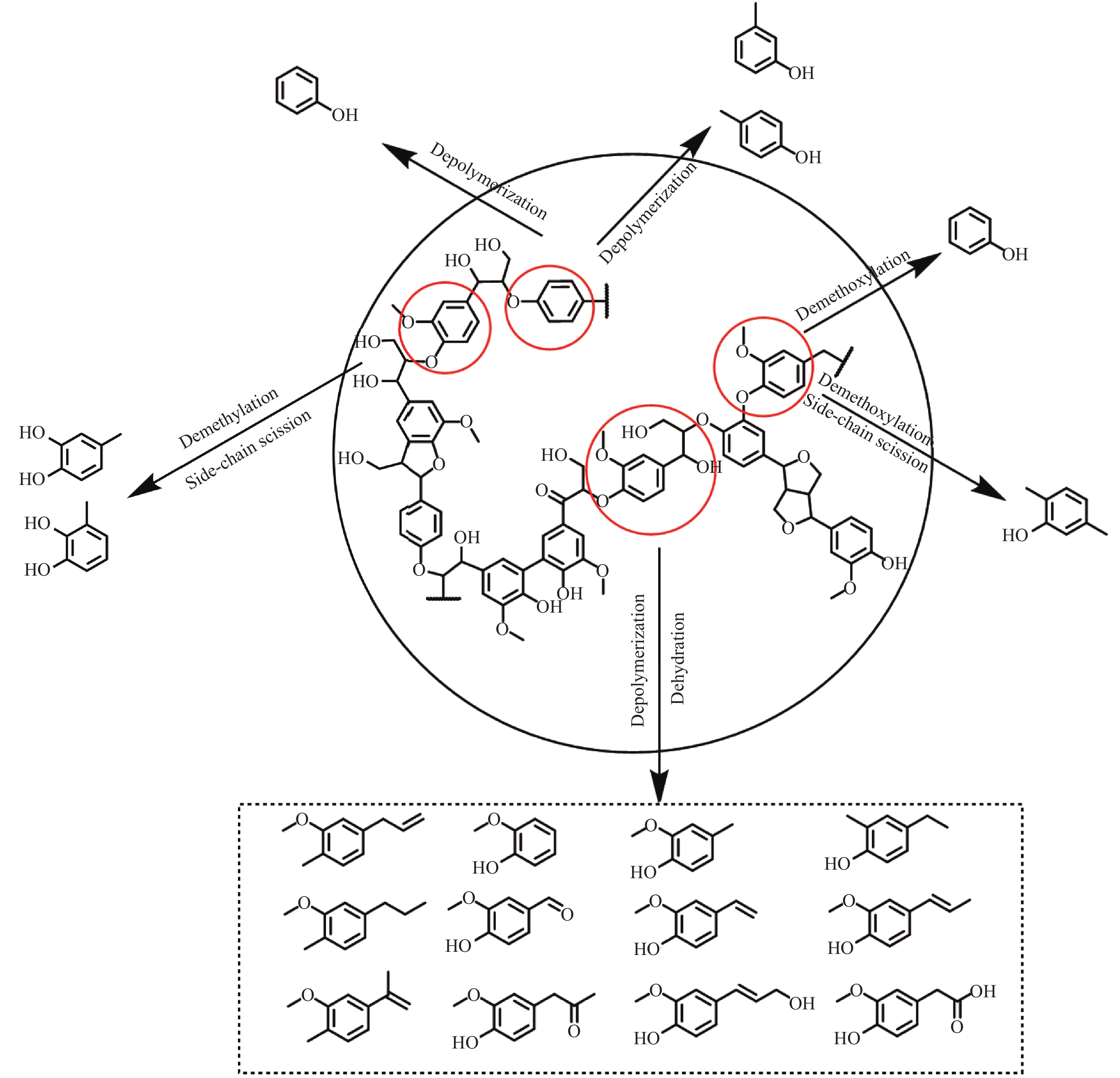Volatile aromatic components and pyrolytic products in ethanol extracts of Cyclocarya paliurus by GC-MS
-
摘要:
为研究青钱柳浸膏作为添加剂应用于卷烟的可行性,采用气相-离子迁移谱(GC-IMS)分析挥发性香气成分,通过单热重-气相色谱-质谱联用技术(TGA-GC/MS)模拟燃烧过程,分析青钱柳浸膏在氮气环境中的裂解产物,并对产物可能的裂解机制进行合理推测。结果表明:醛类、醇类、酮类为青钱柳浸膏的主要挥发性香气成分,占总香气成分的62.28%。在不同温度条件下,青钱柳浸膏裂解产物差异较大,在200 ℃、360 ℃、440 ℃共鉴定出79种化合物,其中24种致香成分对卷烟风格具有重要作用,包括醛、酮、醇、酚、呋喃、芳香族化合物和其他一些天然香气物质,其中含量较多的酚类化合物主要是由含有类似愈创木酚单元和丁香酚单元结构的化合物通过侧链的断裂、脱甲基化、脱甲氧基化、脱水等形成,呋喃及呋喃衍生物主要由糖类或糖苷类化合物通过断裂糖苷键和脱水形成。
Abstract:In order to investigate the feasibility of the extract from Cyclocarya paliurus as an additive in cigarettes, the volatile aromatic components were analyzed by gas chromatography-ion mobility spectrometry (GC-IMS), and C.paliurus extract was pyrolyzed to simulate cigarette smoking by TGA-GC/MS. The cracking products of C.paliurus were analyzed in a nitrogen environment, and the possible cracking mechanism of the products was reasonably speculated. The results showed that aldehydes, alcohols, and ketones were the primary volatile aroma components of the C.paliurus extract, comprising 62.28% of the total aroma components. The cracking products of C.paliurus extract varied greatly under different temperature conditions. A total of 79 compounds were identified at 200,360, and 440 ℃, among which 24 aromatic components were clearly identified as having significant effects on cigarette style, including aldehydes, ketones, alcohols, phenols, furans, benzene series, and other natural aromatic substances. Among them, phenols containing a high concentration are mainly formed by compounds containing the structure of guaiacol unit and eugenol unit by side chain cleavage, demethylation, demethoxylation, dehydration, etc. Furan and its derivatives are mainly formed by glycosides or glycoside compounds by breaking glucoside bonds and dehydration.
-
青钱柳[Cyclocarya paliurus (Batalin) Iljinskaja],为胡桃科青钱柳属植物,主要分布于中国南方,被称为甜茶树或金钱树[1]。以树叶、树皮为入药部位,性温,味辛微苦,具有清热消肿、解毒、止痛等功效[2]。现代研究表明,青钱柳含有黄酮类、三萜类、多酚、多糖和其他人体必需微量元素等多种化学成分[3],具有显著的降血糖、降血脂、降血压等临床功效[4]。同时,青钱柳作为一种可食用的植物,2013年被国家卫生健康委员会列入新资源食品目录,此外还作为推荐A级的珍贵树种于2020年被列入《国家储备林树种目录》(2019年修订版)。
因为其广泛的生理活性功能,在医药和保健食品等领域有着重要的市场潜力和研究意义。与青钱柳相关的研发产品大多用于防治和缓解高血糖、高血脂、高血压,以及增强身体抵抗力。其中以青钱柳叶为原料的梅山减肥神茶已经获得美国食品与药品管理局(FDA)的认可,并成为我国第1个获得美国FDA认可的保健品[5]。
青钱柳叶还可与烟丝混合,制成清香型卷烟和可用于戒烟的香型卷烟[6−7]。然而,关于青钱柳在卷烟增香应用方面的研究仅局限于多糖的增香保润[8],暂未见对其挥发性香味物质和热裂解研究的相关报道。因此,本研究以青钱柳浸膏为研究对象,首次采用气相色谱-离子迁移谱法(GC-IMS)对青钱柳浸膏的挥发性香气成分进行测定,同时利用热重-气相色谱-质谱联用技术(TGA-GC/MS)分析青钱柳浸膏的裂解产物和致香成分,及其裂解产物可能的产生机制,旨在挖掘青钱柳潜在的产品开发新方向,为其在新的产品应用上提供理论指导。
1. 材 料
1.1 材料与试剂
青钱柳干燥叶(于2022年10月采集自安徽石台种植基地,并置阴凉处干燥,经中国药科大学中药资源学教研室秦民坚教授鉴定为青钱柳[Cyclocarya paliurus (Batalin) Iljinskaja],植物标本现存于中国药科大学中药制药系);乙醇(AR级,国药集团化学试剂有限公司);超纯水(18.2 MΩ·cm,实验室纯水仪自制)。
1.2 仪 器
TGA/DSC 3+型热重分析仪、IST16热分析联用系统(瑞士Mettler-Toledo公司);6890N-5975C型气相色谱-质谱联用仪(美国Agilent公司);XP205电子分析天平(感量
0.00001 g);FlavourSpec®型GC-IMS风味分析仪(德国G.A.S.公司);B741/V-805/R-215/B-491型旋转蒸发仪(瑞士Buchi公司);Milli-Q Reference超纯水系统(美国Millipore公司)2. 方 法
2.1 青钱柳浸膏的制备
按实验前期确定的最佳工艺条件制备青钱柳醇提物,即称取干燥的青钱柳叶粉末5 g,加入70%乙醇60 mL,在85 ℃水浴下回流提取2.5 h,提取3次。滤去药渣,滤液合并后低温减压浓缩至稠状后再冷冻干燥,备用。
2.2 GC-IMS分析
GC-IMS条件:取冷冻干燥后的青钱柳浸膏样品0.5 g于顶空瓶中,平行3份,采用气相离子迁移谱仪进行分析,80 ℃孵化15 min,进样量500 µL,载气N2(纯度≥99.999%),色谱柱类型MXT-5(15 m×0.53 mm,1.0 µm);色谱柱温度60 ℃,进样口温度75 ℃,载气流量梯度:初始流速2 mL/min,保持2 min;2~10 min内线性升到10 mL/min;10~20 min内线性升到100 mL/min,保持20 min后停止;IMS:漂移管长度:53 mm;漂移管温度:45 ℃;漂移气:N2(纯度≥99.999%);漂移气流速:150 mL/min;放射源:氚源;离子化模式:正离子模式。
2.3 热重分析
称取青钱柳浸膏约7.5 mg于氧化铝坩埚中,使用热重分析仪对样品进行热重分析。裂解氛围:N2;气体流量:50 mL/min;裂解升温程序:初始温度40 ℃,以10 ℃/min升到
1000 ℃,保持5 min。2.4 TGA-GC/MS分析
分析方法参考文献[9]。称取青钱柳浸膏约7.5 mg于坩埚中,TGA与GC-MS采用IST16联用系统连接,进样模式选择单定量环进样,从DTG曲线中找出质量损失较大的温度,将此温度下对应的时间设定为阀门打开捕集TGA气体时间,定量环容积120 μL,取样时间10 s,GC-MS采用外部设备直接进样模式。
2.4.1 色谱条件
DB-5MS毛细管色谱柱(30 m×0.25 mm, 0.25 µm);进样口温度:250 ℃;载气:He;流速:1 mL/min;分流比:2∶1;升温程序:初始温度40 ℃,保持3 min,从10 ℃/min升至260 ℃,保持10 min。
2.4.2 质谱条件
传输线温度280 ℃;MS电离方式:EI;电离能量:70 eV;离子源温度230 ℃;四极杆温度150 ℃;扫描范围:35~550 amu;溶剂延迟1.8 min。
2.5 数据处理
GC-IMS结果采用配套软件VOCal进行谱图分析,通过内置的NIST数据库和IMS数据库进行化合物的定性识别,使用Gallery Plot插件绘制样品二维谱图和三维谱图,使用Reporter插件绘制样品指纹图谱。TGA-GC/MS结果利用安捷伦GC-MS谱图处理软件Enhanced Data Analysis,通过NIST 17.L质谱数据库进行化合物检索定性,保留正向匹配度(Match)和反向匹配度(R.Match)大于800的化合物。采用峰面积归一化法对裂解产物进行半定量分析。通过Excel对热重分析数据和气质TIC数据进行处理,运用Origin 2022进行作图。
3. 结果与分析
3.1 基于GC-IMS的青钱柳浸膏挥发性香气成分分析
青钱柳浸膏样品经GC-IMS分析生成三维信息谱图(图1),其中y轴为气相色谱仪保留时间,x轴为离子迁移时间,z轴为峰强度。将GC-IMS分析生成的三维谱图进行降维处理后得到二维谱图(俯视图),如图2所示,图中横坐标1.0处红色竖线为反应离子峰(RIP),RIP峰两侧的每个点代表一种挥发性成分,以颜色代表物质的浓度,白色表示浓度较低,红色表示浓度较高,颜色越深表示挥发性成分浓度越高。结果表明:青钱柳浸膏的挥发性成分在
2000 s内完成GC分离,在15 ms内可实现IMS分离。样品中的挥发性成分较为复杂,但大部分挥发性成分在1000 s内出峰并具有较好的分离度。为了明确青钱柳浸膏的挥发性香气成分类别,利用C4-C9的正构酮进行保留时间校准,通过GC-IMS内置数据库中的保留指数和迁移时间对化合物进行二维定性。最终从谱库中鉴定出42个化合物的48个峰,包括10个醛类、8个醇类、7个酮类、3个酯类、1个酸类、4个其他类化合物、9种二聚体、6个未知化合物。其中乙酸、2,4-己二烯醛、2-甲基吡嗪、环己酮、反-2-己烯醛、异戊烯醛、正丁醇、反式-2-戊烯醛、正己醛以单体和二聚体的形式出现。醛类、醇类、酮类为青钱柳浸膏的主要挥发性香气成分,占总香气成分的62.28%。结果见表1。
Table 1. Qualitative results of volatile compounds in C. paliurus extractType Compound CAS Formula RI RT/s DT/s Relative content/% Acids Acetic acid-M C64197 C2H4O2 1506.9 1184.727 1.058 3.14 Acids Acetic acid-D C64197 C2H4O2 1515.8 1201.702 1.165 1.26 Alcohols Propylene glycol C57556 C3H8O2 1713.8 1579.779 1.113 0.69 Alcohols Linalool C78706 C10H18O 1543.1 1253.848 1.207 0.82 Alcohols (Z)-2-Penten-1-ol C1576950 C5H10O 1330.8 848.484 0.944 8.55 Alcohols 3-Methyl-1-butanol C123513 C5H12O 1218.3 664.611 1.238 0.60 Alcohols 1-Penten-3-ol C616251 C5H10O 1167.8 579.743 0.949 6.19 Alcohols 1- Butanol-M C71363 C4H10O 1152.7 551.423 1.182 0.83 Alcohols 1- Butanol-D C71363 C4H10O 1152.2 550.596 1.387 0.38 Alcohols 2-Methyl-1-propanol C78831 C4H10O 1102.4 457.152 1.372 2.53 Alcohols 1-Propanethiol C107039 C3H8S 861.7 251.243 1.165 0.96 Aldehydes (2E,4E)-2,4-Heptadienal C4313035 C7H10O 1500.5 1172.396 1.213 1.25 Aldehydes (2E,4E)-2,4-Hexadienal-M C142836 C6H8O 1443.2 1063.027 1.129 2.56 Aldehydes (2E,4E)-2,4-Hexadienal-D C142836 C6H8O 1444.9 1066.292 1.452 6.41 Aldehydes (E)-2-Hexenal-M C6728263 C6H10O 1231.5 684.312 1.184 1.85 Aldehydes (E)-2-Hexenal-D C6728263 C6H10O 1230.5 682.852 1.514 0.31 Aldehydes 3-Methyl-2-butenal-M C107868 C5H8O 1212.5 655.855 1.093 1.00 Aldehydes 3-Methyl-2-butenal-D C107868 C5H8O 1214.4 658.774 1.362 1.07 Aldehydes (E)-2-Pentenal-M C1576870 C5H8O 1124.0 497.672 1.110 7.42 Aldehydes (E)-2-Pentenal-D C1576870 C5H8O 1123.1 496.018 1.361 1.20 Aldehydes 1-Hexanal-M C66251 C6H12O 1101.0 454.671 1.271 1.23 Aldehydes 1-Hexanal-D C66251 C6H12O 1102.4 457.152 1.560 0.28 Aldehydes 1-Pentanal C110623 C5H10O 969.8 317.399 1.185 1.03 Aldehydes 2-Methyl butanal C96173 C5H10O 930.6 293.417 1.399 0.81 Aldehydes Butanal C123728 C4H8O 850.9 244.628 1.114 0.73 Aldehydes Acrolein C107028 C3H4O 872.5 257.859 1.055 1.22 Esters Ethyl 2-hydroxypropanoate C97643 C5H10O3 1352.6 889.996 1.150 0.52 Esters Ethyl 2-oxopropanoate C617356 C5H8O3 1253.0 716.417 1.149 0.77 Esters Ethyl acetate C141786 C4H8O2 903.6 276.879 1.334 0.43 Ketones 2-Methyl-2-hepten-6-one C110930 C8H14O 1342.5 870.827 1.179 0.42 Ketones 1-Hydroxy-2-propanone C116096 C3H6O2 1307.9 804.705 1.230 0.73 Ketones Cyclohexanone-M C108941 C6H10O 1294.5 779.167 1.155 1.87 Ketones Cyclohexanone-D C108941 C6H10O 1292.9 776.248 1.456 0.26 Ketones 2-Hexanone C591786 C6H12O 1062.7 408.362 1.198 1.39 Ketones 2,3-Pentadione C600146 C5H8O2 1043.1 386.035 1.307 2.13 Ketones 1-Penten-3-one C1629589 C5H8O 1006.0 343.861 1.302 0.82 Ketones 2-Butanone C78933 C4H8O 918.5 285.975 1.243 1.82 Others 2,6-Dimethylpyrazine C108509 C6H8N2 1320.5 828.783 1.134 0.40 Others 2-Methylpyrazine-M C109080 C5H6N2 1308.3 805.434 1.069 1.70 Others 2-Methylpyrazine-D C109080 C5H6N2 1307.9 804.705 1.398 6.75 Others β-Pinene C127913 C10H16 1123.5 496.845 1.223 0.62 Others 2-Propenenitrile C107131 C3H3N 992.8 331.457 1.088 6.50 RI:Retention index; RT:Retention time;DT:Drift time 为了便于观察不同挥发性香气成分在青钱柳浸膏样品中的含量差异,采用Gallery Plot绘制挥发性成分的指纹图谱(图3)。图中每一行代表同一样品中选取的不同信号峰,每一列代表不同样品中同一挥发性成分的信号峰。信号峰颜色越亮,含量越高。从图3指纹图谱并结合表1结果可知,顺-2-戊烯-1-醇(8.55%)、反式-2-戊烯醛二聚体(7.42%)、2-甲基吡嗪(6.75%)、1-戊烯-3-醇(6.19%)、2,4-己二烯醛二聚体(6.41%)、丙烯腈(6.50%)等挥发性物质在青钱柳浸膏中的信号峰强度较高,是青钱柳浸膏中的主要挥发性物质。在鉴定的挥发性成分中,顺-2-戊烯-1-醇具有甜的清新花香和叶子香,1-戊烯-3-醇具马铃薯味和水果香,芳樟醇具有木青气息和绿茶清香,正己醛具清香、花香、甜香,(E)-2-己烯醛具清叶香气,反式-2-戊烯醛具马铃薯味和豌豆香气,甲基庚烯酮具青草香气,2-甲基吡嗪具浓郁甜花香。这些香气成分共同构成了青钱柳浸膏特有的香气特征。
![]() Figure 3. GC-IMS fingerprint of volatile components of C. paliurus extract Each row represents the signal peak of one sample while each column represents the same volatile component in different samples. Colors represent the content of a volatile compound, and the brighter the color is, the higher the content
Figure 3. GC-IMS fingerprint of volatile components of C. paliurus extract Each row represents the signal peak of one sample while each column represents the same volatile component in different samples. Colors represent the content of a volatile compound, and the brighter the color is, the higher the content3.2 青钱柳浸膏的热失重特性分析
青钱柳浸膏的TG曲线和DTG曲线如图4-A和图4-B所示。由图可知,青钱柳浸膏在热裂解过程中出现了3个明显的失重区间。
第一阶段,从初始温度升高到120 ℃,为青钱柳浸膏内部游离水和结合水蒸发的过程。第二阶段,从120 ℃开始一直持续到650 ℃,是青钱柳浸膏的主要质量损失阶段。在这个阶段,伴随着各种化学反应的发生和化学键的断裂,产生大量的挥发性成分,其中包括青钱柳浸膏中本身存在的挥发性成分和裂解后产生的挥发性成分。在这个失重区间,存在3个失重速率较大的温度点,分别在200℃下失重14.07%、360 ℃下失重35.39%、440 ℃下失重12.99%。第三阶段,主要是残渣的碳化过程,当温度达到650 ℃时,青钱柳浸膏已失重70.92%,800 ℃之后是一段缓慢的轻微失重,持续到
1000 ℃。残渣存留质量为10.20%。3.3 不同热裂解温度对裂解产物的影响
青钱柳浸膏裂解后经气相色谱-质谱联用仪分析,其在200、360、440 ℃下的裂解产物总离子流图见图5-A、图5-B、图5-C。所经与NIST谱库的标准质谱图比对,分别鉴定出20、33、42种化合物,详细结果见表2。
Table 2. Pyrolysis products of C.paliurus extract at 200 ℃,360 ℃,and 440 ℃RT/s Compound CAS Match R.Match Relative content/% 200 ℃ 360 ℃ 440 ℃ 2.528 Acetic acid 64-19-7 898 941 7.222 ND ND 2.557 2-Methyl-furan 534-22-5 735 810 ND 9.426 ND 2.863 2,4-Hexadiene 5194 -51-4886 886 6.653 ND ND 3.152 2-Propanone, 1-hydroxy- 116-09-6 844 905 6.395 ND ND 3.546 2,3-Pentanedione 600-14-6 848 848 1.792 ND ND 3.704 Furan, 2,5-dimethyl- 625-86-5 821 838 ND 2.405 ND 4.739 Toluene 108-88-3 866 883 ND 2.317 3.991 5.192 Cyclopentanone 120-92-3 849 859 ND 0.393 ND 5.381 Heptane,2,4-dimethyl 2213 -23-2865 865 ND ND 1.058 5.504 3(2H)-Furanone, dihydro-2-methyl- 3188 -00-9800 800 0.854 ND ND 5.986 2-Cyclopenten-1-one 930-30-3 787 912 ND 2.244 ND 6.028 Furfural 98-01-1 878 889 23.993 ND ND 6.422 Furfuryl alcohol 98-00-0 907 907 10.180 ND ND 6.575 Ethylbenzene 100-41-4 863 919 ND ND 0.977 6.704 2-Propanone, 1-(acetyloxy)- 592-20-1 847 855 0.990 ND ND 6.763 p-Xylene 106-42-3 935 937 ND 3.699 4.945 6.963 4-Cyclopentene-1,3-dione 930-60-9 886 886 2.101 ND ND 7.192 o-Xylene 95-47-6 870 906 ND ND 1.436 7.357 Nonane 111-84-2 854 854 ND ND 1.117 7.404 2-Cyclopenten-1-one, 2-methyl- 1120 -73-6802 849 ND 0.871 ND 7.498 Ethanone, 1- (2-furanyl)- 1192 -62-7843 843 ND 2.015 ND 7.792 p-Benzoquinone 106-51-4 821 839 ND 5.066 1.061 8.375 Benzene, propyl- 103-65-1 907 907 ND ND 0.202 8.504 2-Furancarboxaldehyde, 5-methyl- 620-02-0 916 921 4.019 ND ND 8.51 Benzene, 1-ethyl-2-methyl- 611-14-3 914 930 ND ND 1.368 8.569 Benzene, 1-ethyl-4-methyl- 622-96-8 877 885 ND ND 1.326 8.663 Benzene,1,2,4-trimethyl- 95-63-6 912 912 ND ND 0.764 8.769 Phenol 108-95-2 953 973 ND 10.862 4.216 9.192 3,3,5-Trimethyl-1,5-heptadiene 74630 -29-8807 838 ND 0.804 ND 9.604 Mesitylene 108-67-8 847 920 ND 2.104 2.331 9.68 Benzene, 1-methyl-3-(1-methylethyl)- 535-77-3 800 811 ND 2.122 0.515 9.774 D-Limonen 5989 -27-5916 924 ND 2.818 ND 9.816 Benzyl alcohol 100-51-6 800 800 2.343 1.990 ND 10.022 Benzene, 1-ethynyl-4-methyl- 766-97-2 863 894 ND ND 0.142 10.092 Phenol,2-methyl- 95-48-7 928 928 ND 0.669 2.042 10.227 Benzene, 1,4-diethyl- 105-05-5 839 859 ND ND 0.921 10.38 Acetophenone 98-86-2 854 854 ND 0.367 ND 10.445 p-Cresol 106-44-5 917 919 ND 3.687 3.714 10.586 2 5-Furandicarboxaldehyde 823-82-6 918 937 3.093 ND ND 10.598 1-Ethyl-2,4-dimethylbenzene 874-41-9 872 872 ND ND 0.580 10.698 Mequinol 150-76-5 850 923 ND 1.648 ND 10.798 Benzene, 1-methyl-4-(1-methylethenyl)- 1195 -32-0832 895 ND 0.815 ND 10.939 Undecane 1120 -21-4900 900 ND ND 0.705 11.033 Phenol, 2,5-dimethyl- 95-87-4 800 875 ND ND 0.706 11.104 Benzofuran, 2-methyl- 4265 -25-2881 881 ND ND 0.294 11.292 Benzene, 1,2,4,5-tetramethyl- 95-93-2 916 916 ND ND 0.735 11.457 Phenol, 2-ethyl- 90-00-6 808 866 ND ND 0.370 11.651 Phenol, 2,4-dimethyl- 105-07-9 843 928 ND ND 2.307 11.927 Phenol, 4-ethyl- 123-07-9 901 964 ND 1.406 ND 12.492 α-Terpineol 98-55-2 866 877 3.324 1.254 12.715 Benzofuran, 2,3-dihydro- 496-16-2 800 872 ND 1.552 ND 12.81 Benzofuran,4,7-dimethyl 28715 -26-6808 808 ND ND 0.591 12.845 5-Hydroxymethylfurfural 67-47-0 745 786 2.141 ND ND 13.404 Naphthalene,1,2-dihydro-4-methyl- 4373 -13-1843 879 ND ND 0.316 13.433 Hydroquinone 123-31-9 893 908 ND 5.873 1. 402 13.645 Cinnamaldehyde, (E)- 14371 -10-9892 910 3.759 1.733 ND 13.78 1H-Indene,2,3-dihydro-4,7-dimethyl- 6682 -71-9809 835 ND ND 0.753 13.98 Tridecane 629-50-5 858 900 ND ND 0.884 14.086 2-Propen-1-ol, 3-phenyl- 104-54-1 939 939 12.898 6.157 ND 14.41 1H-Indene,2,3-dihydro-1,1,5-trimethyl- 40650 -41-7829 831 ND ND 1.408 15.08 2-Propadienylmesitylene 29555 -07-5800 912 ND ND 0.517 15.351 Tetradecane 629-59-4 816 907 ND ND 1.113 15.456 Diphenyl ether 101-84-8 831 856 0.447 0.254 ND 15.562 Naphthalene, 1,8-dimethyl- 569-41-5 830 869 ND ND 1.117 15.692 Ethanone, 1-(3-hydroxyphenyl)- 121-71-1 909 909 0.193 ND ND 15.792 Naphthalene, 2,6-dimethyl- 581-42-0 872 928 ND ND 1.261 16.574 Benzene, 1,2-dimethoxy-4-propenyl-, (E)- 6379 -72-2871 894 0.919 1.740 ND 16.815 1-Naphthalenol 96-15-3 800 816 ND 0.253 ND 17.056 Naphthalene, 2-ethoxy- 93-18-5 938 947 2.280 1.707 ND 17.515 Naphthalene, 1,6,7-trimethyl- 2245 -38-7914 929 ND ND 2.292 17.845 Naphthalene,2,3,6-trimethyl- 829-26-5 892 898 ND ND 1.703 18.156 (+)-Cedrol 77-53-2 817 834 ND 1.461 ND 19.521 Tetramethylnaphthalene 2717 -39-7851 851 ND ND 0.596 20.509 Neophytadiene 504-96-1 800 800 ND 0.286 ND 由图5可知,随着裂解温度的提高,裂解产物越来越复杂,从200 ℃的20种化合物,增加到440 ℃的42种化合物。从化合物类型上来看,低温条件下的裂解产物主要是醛酮、呋喃及呋喃衍生物类;较高温度下,热裂解更为剧烈,主要是苯及其同系物类化合物。从化合物组分上看,在200 ℃下,主要裂解产物为糠醛、糠醇、肉桂醇、乙酸、2,4-己二烯、羟基丙酮、5-甲基-2-糠醛、4-环戊烯-1,3-二酮、α-松油醇、2,5-二甲酰基呋喃等物质。与200 ℃的裂解产物相比,360 ℃主要增加了苯酚、2-甲基呋喃、苯醌、甲苯、对二甲苯、对甲酚、对苯二酚、均三甲苯等杂环类化合物、芳香族类物质。在440 ℃时的裂解产物与360 ℃时裂解的产物种类相似,但芳香族类物质种类明显增多,如甲苯、邻乙基甲苯、4-乙基甲苯、1,2,3-三甲苯、2,3-二氢-4,7-二甲基-1H-茚、1,8-二甲基萘、2,3,5-三甲基萘、2,3,6-三甲基萘等物质。与前两个温度条件下裂解产物有所不同的是,在440 ℃下,开始检测到茚、萘类等稠合度较高的化合物。这些结果提示,随着裂解温度的提高,裂解产物的复杂程度在不断提高,由小分子的杂环类、醛酮类化合物,逐渐向芳环化合物过渡,当温度进一步提高时,这些物质发生裂解、聚合和缩合,并转化为萘、菲等更为稳定的稠环芳烃[10]。
3.4 裂解产物的致香成分分析
由表2可知,裂解产物中检出的化合物包括醇、醛、酮、酚、酸、醚、呋喃类、苯及其同系物类等多种化合物类型。其中绝大部分物质都具有特殊的香味,可在不同程度上提升卷烟风味。如糠醛、糠醇、2-甲基呋喃、2,5-二甲基呋喃、5-甲基-2-糠醛、5-羟甲基糠醛、2,5-二甲酰基呋喃、2-甲基苯并呋喃、2,3-二氢苯并呋喃、4,7-二甲基苯并呋喃等呋喃类化合物是卷烟主流烟气中重要的香味物质,影响卷烟的风味特征和品质。其中糠醛具有甜香和面包香,可赋予卷烟烘烤食品的香气[11];5-甲基-2-糠醛具有浓郁的辛香、甜香气味和甜的焦糖气味,可增加卷烟整体甜香香气[12];2-乙酰基呋喃具有甜香、焦香、咖啡味[13]。
醇类物质在卷烟中主要起保润作用,同时兼具改善烟香味,柔和烟气的作用。如苯甲醇可以增加卷烟的果香香韵,增加卷烟的甜润度[14];酮类物质能够协调烟香、掩盖杂气、赋予卷烟不同的香韵特征,改善卷烟的吸味、香气和满足感[15]。如苯乙酮具有山楂香气[16],2-甲基四氢呋喃-3-酮具有甜、焦糖、老姆酒及奶油[17]气味。
部分酚类物质是烟叶中的重要致香成分[18]。如邻甲酚可增加丰满甜润、白肋烟特征,对甲苯酚具有酚香味[19],对苯二酚具有甜苜蓿的香气和酚味[20],4-乙基苯酚是烟熏香的重要成分[21],甲基异丁香酚具柔和甜清的辛香,有石竹和丁香花样香气,是烟叶的重要香味物质[21−22]。
苯及其同系物,如甲苯、乙苯、4-乙炔基甲苯、均三甲苯、2-甲基苯并呋喃等,由于在高温条件下提供的能量大于反应所需的活化能,很快会转化为萘、苊、菲等稠环芳烃和芳香族化合物,进而导致更加强烈的卷烟加香效果[23]。
此外,本研究还检测到一些青钱柳醇提物中天然存在的香气成分,例如肉桂醛具有温和的辛香气息[12];新植二烯是烟叶的重要致香剂,具有捕集并携带其他香气物质进入烟气的能力,同时其降解产物还具有增加烤烟香气作用[24];雪松醇具有木香和辛香的香气[25];α-松油醇具有丁香味和金银花香气[26];D-柠檬烯为多种水果的天然成分,主要存在于柑橘类植物中,具有橘子香、水果香、薄荷味和橙皮味[27]。
3.5 热裂解机制分析
在不同裂解温度条件下,200 ℃下产生了大量的糠醛(23.993%)和糠醇(10.180%),在360 ℃时则苯酚(10.862%)和2-甲基呋喃(9.426%)2,5-二甲基呋喃(2.405%)、2-乙酰基呋喃(2.015%)、对苯二酚(5.873%)、4-甲氧基苯酚(1.648%)、反-甲基异丁香酚(1.740%)含量较高,440 ℃甲苯(3.991%)和对二甲苯(4.945%)含量较高,同时出现茚、萘等稠环芳烃。
羰基类、呋喃类化合物主要是由糖类产生,随着裂解温度的提高,这类化合物发生糖苷键断裂和脱水反应形成醛酮类化合物、呋喃及呋喃类衍生物[28]。以葡萄糖为例,当糖之间以β-1,2-糖苷键相连时,在74 ℃左右开始发生β-1,2-糖苷键的断裂,并进一步脱水形成糠醛、5-羟甲基糠醛、2,5-二甲基呋喃、2-乙酰基呋喃等呋喃及呋喃衍生物(图6)。根据Lu等[29]和Hu等[30]的研究,酚类化合物的产生,则涉及到各种化合键的断裂(图7),包括脂肪族侧链的-OH官能团断裂,烷基侧链断裂、芳醚断裂。其中,芳香环脂肪侧链断裂会产生羟基自由基,β-断裂反应会产生氢自由基,氢自由基与氧自由基一起迁移到脂肪侧链或芳香环上从而形成大量的甲氧基苯酚;含有愈创木脂基的化合物可通过脱水反应形成苯酚;通过去甲基化和去甲氧基化可形成甲酚类、邻苯二酚类化合物。随着裂解温度的提高,裂解形成的化合物中苯环自由基、支链较少或较短的芳基自由基发生进一步缩合和聚合形成茚、萘等稠环化合物[10]。整个裂解过程及产物与本研究实验结果相似,故推测在200~360 ℃之间,青钱柳浸膏的少量单糖、多糖及糖苷类化合物由于发生各种糖苷键的断裂和脱水过程形成了大量的呋喃和呋喃衍生物;而青钱柳中一些多酚类化合物、含有愈创木酚单元化合物、含有芳香环、脂肪链、芳醚键等多种基团的化合物易产生甲氧基苯酚、甲酚、邻苯二酚类;产生的部分裂解成分在440 ℃通过缩合、聚合进一步又形成茚和萘类化合物。
4. 讨 论
挥发性香气物质是食品和烟草领域的一项重要研究内容,气相色谱-质谱联用仪(GC-MS)和气相色谱-离子迁移谱(GC-IMS)是2种常见的挥发性物质分析技术。与GC-MS相比,GC-IMS具有分析时间短、响应速度快、灵敏度高、可视化程度高等多种优势[31−33],且无须样品前处理,可弥补GC-MS对于痕量小分子物质检测灵敏度低和重现性不足的问题,被广泛应用于药材、植物及烟草中挥发性香气物质的分析[34]。本研究首次利用GC-IMS对青钱柳浸膏中的挥发性香气物质进行分析,共检测出42种挥发性香气化合物,其中顺-2-戊烯-1-醇、反式-2-戊烯醛、2-甲基吡嗪(6.75%)、1-戊烯-3-醇、2,4-己二烯醛、芳樟醇、(E)-2-己烯醛、反式-2-戊烯醛、甲基庚烯酮等是其主要的香气来源。从检测结果来看,与陈玮玲等[35]、寇晓琳等[36]运用GC-MS分析得到的结果存在一定差异,本研究鉴定的挥发性成分主要为C10以内的小分子醛、酮类香气成分,而对于β-紫罗兰酮、β-瑟林烯、石竹烯、β-榄香烯、雪松醇等C10以上的香气物质未能检测到。这可能与GC-IMS的仪器特性和适用性有关。
热重-气相色谱-质谱联用技术常用于模拟燃烧过程挥发性物质的释放规律,可分析样品在某一温度下的挥发性成分,在一定程度上可弥补GC-IMS挥发性成分鉴定的局限性,同时可分析同一样品在不同温度条件下裂解产物中的挥发性香气物质的变化情况。本研究首次通过TGA-GC/MS连用技术,从热裂解的角度,分析青钱柳浸膏在200、360、440 ℃下的挥发性成分,明确了糠醛、糠醇、2-乙酰基呋喃、苯甲醇、苯乙酮、α-松油醇、D-柠檬烯、新植二烯、雪松醇等能提升卷烟风格,改善抽吸品质的致香成分。这说明青钱柳浸膏适用于添加到卷烟中,通过对青钱柳浸膏挥发性香气物质分析、热裂解产物研究及其产物机制推测,可为其在卷烟中的应用提供理论指导,具有一定的开发空间和可行性。
-
Figure 3. GC-IMS fingerprint of volatile components of C. paliurus extract Each row represents the signal peak of one sample while each column represents the same volatile component in different samples. Colors represent the content of a volatile compound, and the brighter the color is, the higher the content
Table 1 Qualitative results of volatile compounds in C. paliurus extract
Type Compound CAS Formula RI RT/s DT/s Relative content/% Acids Acetic acid-M C64197 C2H4O2 1506.9 1184.727 1.058 3.14 Acids Acetic acid-D C64197 C2H4O2 1515.8 1201.702 1.165 1.26 Alcohols Propylene glycol C57556 C3H8O2 1713.8 1579.779 1.113 0.69 Alcohols Linalool C78706 C10H18O 1543.1 1253.848 1.207 0.82 Alcohols (Z)-2-Penten-1-ol C1576950 C5H10O 1330.8 848.484 0.944 8.55 Alcohols 3-Methyl-1-butanol C123513 C5H12O 1218.3 664.611 1.238 0.60 Alcohols 1-Penten-3-ol C616251 C5H10O 1167.8 579.743 0.949 6.19 Alcohols 1- Butanol-M C71363 C4H10O 1152.7 551.423 1.182 0.83 Alcohols 1- Butanol-D C71363 C4H10O 1152.2 550.596 1.387 0.38 Alcohols 2-Methyl-1-propanol C78831 C4H10O 1102.4 457.152 1.372 2.53 Alcohols 1-Propanethiol C107039 C3H8S 861.7 251.243 1.165 0.96 Aldehydes (2E,4E)-2,4-Heptadienal C4313035 C7H10O 1500.5 1172.396 1.213 1.25 Aldehydes (2E,4E)-2,4-Hexadienal-M C142836 C6H8O 1443.2 1063.027 1.129 2.56 Aldehydes (2E,4E)-2,4-Hexadienal-D C142836 C6H8O 1444.9 1066.292 1.452 6.41 Aldehydes (E)-2-Hexenal-M C6728263 C6H10O 1231.5 684.312 1.184 1.85 Aldehydes (E)-2-Hexenal-D C6728263 C6H10O 1230.5 682.852 1.514 0.31 Aldehydes 3-Methyl-2-butenal-M C107868 C5H8O 1212.5 655.855 1.093 1.00 Aldehydes 3-Methyl-2-butenal-D C107868 C5H8O 1214.4 658.774 1.362 1.07 Aldehydes (E)-2-Pentenal-M C1576870 C5H8O 1124.0 497.672 1.110 7.42 Aldehydes (E)-2-Pentenal-D C1576870 C5H8O 1123.1 496.018 1.361 1.20 Aldehydes 1-Hexanal-M C66251 C6H12O 1101.0 454.671 1.271 1.23 Aldehydes 1-Hexanal-D C66251 C6H12O 1102.4 457.152 1.560 0.28 Aldehydes 1-Pentanal C110623 C5H10O 969.8 317.399 1.185 1.03 Aldehydes 2-Methyl butanal C96173 C5H10O 930.6 293.417 1.399 0.81 Aldehydes Butanal C123728 C4H8O 850.9 244.628 1.114 0.73 Aldehydes Acrolein C107028 C3H4O 872.5 257.859 1.055 1.22 Esters Ethyl 2-hydroxypropanoate C97643 C5H10O3 1352.6 889.996 1.150 0.52 Esters Ethyl 2-oxopropanoate C617356 C5H8O3 1253.0 716.417 1.149 0.77 Esters Ethyl acetate C141786 C4H8O2 903.6 276.879 1.334 0.43 Ketones 2-Methyl-2-hepten-6-one C110930 C8H14O 1342.5 870.827 1.179 0.42 Ketones 1-Hydroxy-2-propanone C116096 C3H6O2 1307.9 804.705 1.230 0.73 Ketones Cyclohexanone-M C108941 C6H10O 1294.5 779.167 1.155 1.87 Ketones Cyclohexanone-D C108941 C6H10O 1292.9 776.248 1.456 0.26 Ketones 2-Hexanone C591786 C6H12O 1062.7 408.362 1.198 1.39 Ketones 2,3-Pentadione C600146 C5H8O2 1043.1 386.035 1.307 2.13 Ketones 1-Penten-3-one C1629589 C5H8O 1006.0 343.861 1.302 0.82 Ketones 2-Butanone C78933 C4H8O 918.5 285.975 1.243 1.82 Others 2,6-Dimethylpyrazine C108509 C6H8N2 1320.5 828.783 1.134 0.40 Others 2-Methylpyrazine-M C109080 C5H6N2 1308.3 805.434 1.069 1.70 Others 2-Methylpyrazine-D C109080 C5H6N2 1307.9 804.705 1.398 6.75 Others β-Pinene C127913 C10H16 1123.5 496.845 1.223 0.62 Others 2-Propenenitrile C107131 C3H3N 992.8 331.457 1.088 6.50 RI:Retention index; RT:Retention time;DT:Drift time Table 2 Pyrolysis products of C.paliurus extract at 200 ℃,360 ℃,and 440 ℃
RT/s Compound CAS Match R.Match Relative content/% 200 ℃ 360 ℃ 440 ℃ 2.528 Acetic acid 64-19-7 898 941 7.222 ND ND 2.557 2-Methyl-furan 534-22-5 735 810 ND 9.426 ND 2.863 2,4-Hexadiene 5194 -51-4886 886 6.653 ND ND 3.152 2-Propanone, 1-hydroxy- 116-09-6 844 905 6.395 ND ND 3.546 2,3-Pentanedione 600-14-6 848 848 1.792 ND ND 3.704 Furan, 2,5-dimethyl- 625-86-5 821 838 ND 2.405 ND 4.739 Toluene 108-88-3 866 883 ND 2.317 3.991 5.192 Cyclopentanone 120-92-3 849 859 ND 0.393 ND 5.381 Heptane,2,4-dimethyl 2213 -23-2865 865 ND ND 1.058 5.504 3(2H)-Furanone, dihydro-2-methyl- 3188 -00-9800 800 0.854 ND ND 5.986 2-Cyclopenten-1-one 930-30-3 787 912 ND 2.244 ND 6.028 Furfural 98-01-1 878 889 23.993 ND ND 6.422 Furfuryl alcohol 98-00-0 907 907 10.180 ND ND 6.575 Ethylbenzene 100-41-4 863 919 ND ND 0.977 6.704 2-Propanone, 1-(acetyloxy)- 592-20-1 847 855 0.990 ND ND 6.763 p-Xylene 106-42-3 935 937 ND 3.699 4.945 6.963 4-Cyclopentene-1,3-dione 930-60-9 886 886 2.101 ND ND 7.192 o-Xylene 95-47-6 870 906 ND ND 1.436 7.357 Nonane 111-84-2 854 854 ND ND 1.117 7.404 2-Cyclopenten-1-one, 2-methyl- 1120 -73-6802 849 ND 0.871 ND 7.498 Ethanone, 1- (2-furanyl)- 1192 -62-7843 843 ND 2.015 ND 7.792 p-Benzoquinone 106-51-4 821 839 ND 5.066 1.061 8.375 Benzene, propyl- 103-65-1 907 907 ND ND 0.202 8.504 2-Furancarboxaldehyde, 5-methyl- 620-02-0 916 921 4.019 ND ND 8.51 Benzene, 1-ethyl-2-methyl- 611-14-3 914 930 ND ND 1.368 8.569 Benzene, 1-ethyl-4-methyl- 622-96-8 877 885 ND ND 1.326 8.663 Benzene,1,2,4-trimethyl- 95-63-6 912 912 ND ND 0.764 8.769 Phenol 108-95-2 953 973 ND 10.862 4.216 9.192 3,3,5-Trimethyl-1,5-heptadiene 74630 -29-8807 838 ND 0.804 ND 9.604 Mesitylene 108-67-8 847 920 ND 2.104 2.331 9.68 Benzene, 1-methyl-3-(1-methylethyl)- 535-77-3 800 811 ND 2.122 0.515 9.774 D-Limonen 5989 -27-5916 924 ND 2.818 ND 9.816 Benzyl alcohol 100-51-6 800 800 2.343 1.990 ND 10.022 Benzene, 1-ethynyl-4-methyl- 766-97-2 863 894 ND ND 0.142 10.092 Phenol,2-methyl- 95-48-7 928 928 ND 0.669 2.042 10.227 Benzene, 1,4-diethyl- 105-05-5 839 859 ND ND 0.921 10.38 Acetophenone 98-86-2 854 854 ND 0.367 ND 10.445 p-Cresol 106-44-5 917 919 ND 3.687 3.714 10.586 2 5-Furandicarboxaldehyde 823-82-6 918 937 3.093 ND ND 10.598 1-Ethyl-2,4-dimethylbenzene 874-41-9 872 872 ND ND 0.580 10.698 Mequinol 150-76-5 850 923 ND 1.648 ND 10.798 Benzene, 1-methyl-4-(1-methylethenyl)- 1195 -32-0832 895 ND 0.815 ND 10.939 Undecane 1120 -21-4900 900 ND ND 0.705 11.033 Phenol, 2,5-dimethyl- 95-87-4 800 875 ND ND 0.706 11.104 Benzofuran, 2-methyl- 4265 -25-2881 881 ND ND 0.294 11.292 Benzene, 1,2,4,5-tetramethyl- 95-93-2 916 916 ND ND 0.735 11.457 Phenol, 2-ethyl- 90-00-6 808 866 ND ND 0.370 11.651 Phenol, 2,4-dimethyl- 105-07-9 843 928 ND ND 2.307 11.927 Phenol, 4-ethyl- 123-07-9 901 964 ND 1.406 ND 12.492 α-Terpineol 98-55-2 866 877 3.324 1.254 12.715 Benzofuran, 2,3-dihydro- 496-16-2 800 872 ND 1.552 ND 12.81 Benzofuran,4,7-dimethyl 28715 -26-6808 808 ND ND 0.591 12.845 5-Hydroxymethylfurfural 67-47-0 745 786 2.141 ND ND 13.404 Naphthalene,1,2-dihydro-4-methyl- 4373 -13-1843 879 ND ND 0.316 13.433 Hydroquinone 123-31-9 893 908 ND 5.873 1. 402 13.645 Cinnamaldehyde, (E)- 14371 -10-9892 910 3.759 1.733 ND 13.78 1H-Indene,2,3-dihydro-4,7-dimethyl- 6682 -71-9809 835 ND ND 0.753 13.98 Tridecane 629-50-5 858 900 ND ND 0.884 14.086 2-Propen-1-ol, 3-phenyl- 104-54-1 939 939 12.898 6.157 ND 14.41 1H-Indene,2,3-dihydro-1,1,5-trimethyl- 40650 -41-7829 831 ND ND 1.408 15.08 2-Propadienylmesitylene 29555 -07-5800 912 ND ND 0.517 15.351 Tetradecane 629-59-4 816 907 ND ND 1.113 15.456 Diphenyl ether 101-84-8 831 856 0.447 0.254 ND 15.562 Naphthalene, 1,8-dimethyl- 569-41-5 830 869 ND ND 1.117 15.692 Ethanone, 1-(3-hydroxyphenyl)- 121-71-1 909 909 0.193 ND ND 15.792 Naphthalene, 2,6-dimethyl- 581-42-0 872 928 ND ND 1.261 16.574 Benzene, 1,2-dimethoxy-4-propenyl-, (E)- 6379 -72-2871 894 0.919 1.740 ND 16.815 1-Naphthalenol 96-15-3 800 816 ND 0.253 ND 17.056 Naphthalene, 2-ethoxy- 93-18-5 938 947 2.280 1.707 ND 17.515 Naphthalene, 1,6,7-trimethyl- 2245 -38-7914 929 ND ND 2.292 17.845 Naphthalene,2,3,6-trimethyl- 829-26-5 892 898 ND ND 1.703 18.156 (+)-Cedrol 77-53-2 817 834 ND 1.461 ND 19.521 Tetramethylnaphthalene 2717 -39-7851 851 ND ND 0.596 20.509 Neophytadiene 504-96-1 800 800 ND 0.286 ND -
[1] Chen ZL, Jian YQ, Wu Q, et al. Cyclocarya paliurus (batalin) iljinskaja: botany, ethnopharmacology, phytochemistry and pharmacology[J]. J Ethnopharmacol, 2022, 285 : 114912.
[2] Zhang HY. The Chinese Traditional Medicine Resource (中国中药资源志要) Records. Beijing: Science Press, 1994: 159. [3] Shen YB, Peng Y, Zhu XC, et al. The phytochemicals and health benefits of Cyclocarya paliurus (Batalin) Iljinskaja[J]. Front Nutr, 2023, 10: 1158158. doi: 10.3389/fnut.2023.1158158
[4] Wang H, Tang C, Gao ZZ, et al. Potential role of natural plant medicine Cyclocarya paliurus in the treatment of type 2 diabetes mellitus[J]. J Diabetes Res, 2021, 2021: 1655336.
[5] Wang KP, Li WR, Song MZ, et al. Research progress on chemical constituents, biological activities and product development of Cyclocarya paliurus[J]. Chin J Hosp Pharm, 2023, 43(18): 2100-2104.
[6] Wang J, Mao Y, Yang WY, et al. A preparation method of plant faint-scent cigarette: CN105077574B[P]. 2018-09-21.
[7] Li GM. A kind of smoking cessation cigarettes-Cyclocarya paliurus cigarettes: CN104799427B[P]. 2017-01-11.
[8] Liu H, Chu GL, Ren ZY, et al. Study on the moisturizing and flavor-increasing mechanism of polysaccharides and its application in cigarettes[J]. Food Ind (食品工业), 2022, 43(7): 39-44. [9] Zhu LJ, Cao Y, Qin YH, et al. Effect of glycerol addition ratio on thermal properties and pyrolysis products of tobacco sheet of heated cigarette[J]. Acta Tabacaria Sin (中国烟草学报), 2022, 28(5): 8-16. [10] Luo RC, Zhao ZY, Liu HG, et al. Effect of pyrolytic temperature of β-carotene on the pyrolytic products[J]. J Food Sci Biotechnol (食品与生物技术学报), 2003(3): 67-75. [11] Han Y, Yang Z, Zou XM, et al. Analysis of volatile components and thermal cracking products of Buxus fruit extract and its application in cigarettes[J]. Light Ind Sci Technol (轻工科技), 2021, 37(8): 4-7. [12] Zhang WL, Rong H, Zhao XD, et al. Pyrolysis Constituents of Elsholtzia bodineri Vaniot and effects of the same on deliveries of seven harmful components in mainstream cigarette smoke[J]. J Yunnan Agric Univ (云南农业大学学报), 2018, 33(6): 1105-1112. [13] Hai XC. Study on the characteristic flavor of caramel malt and its changing law in the roasting process (焦香麦芽特征风味及其在焙焦过程中变化规律研究) [D]. Yangzhou: Yangzhou University, 2019. [14] Guan TQ, Zhang B, Zhang L, et al. Analysis of pyrolysis products of Peru extract[J]. Light Ind Sci Technol (轻工科技), 2018, 34(2): 5-6,148. [15] Li C, Liu JY, Cai JY, et al. Analysis of aroma compounds in different flavored cigarette paper by using headspace-gas chromatography-ion mobility spectrometry[J]. J Light Ind (轻工学报), 2023, 38(2): 80-86. [16] Tian LM, Miao EM, Zeng WL, et al. Pyrolysis products analysis of honeysuckle by gas chromatography-mass spectrometer[J]. Chin Agric Sci Bull (中国农学通报), 2017, 33(5): 116-121. [17] Liu XG, Chen YS. Study on synthesis of 2-methyltetrafuran-3-one from ethyl lactate and methyl acrylate[J]. Food Sci (食品科学), 2005, 26(5): 165-167. [18] Wang B, Fan Z, Li HL, et al. Effect of ventilation on the release of typical phenolic flavor components in mainstream cigarette smoke[J]. J Light Ind (轻工学报), 2022, 37(4): 58-65. [19] Dai JG, Li YJ, Zhang P, et al. Study on the pyrolysis behavior of loquat leaf extract[J]. J Light Ind (轻工学报), 2015, 30(1): 30-35. [20] Zhu H, Chai GB, Chi GJ, et al. Sensory-oriented analysis of smoky components in mainstream cigarette smoke[J]. Tob Sci Technol (烟草科技), 2017, 50(1): 41-49. [21] Liao HY, Wu Y, Sun HP, et al. Analysis of methyleugenol in mainstream cigarette smoke by solid phase extractiondouble packing reverse extraction coupled with GC/MS[J]. Tob Sci Technol (烟草科技), 2021, 54(4): 66-73. [22] Wang HJ, Jing XY, Liu LF, et al. Analysis of volatile components in Pimenta dioica leaf oil and its application in cigarette[J]. J Henan Agric Sci (河南农业科学), 2013, 42(3): 143-145. [23] Chu GL. Analysis of pyrolytic properties of polysaccharides and its application in cigarette (多糖的热裂解性质分析及其在卷烟中的应用) [D]. Nanchang: Nanchang University, 2023. [24] Huang YC, Gong CR, Guo R, et al. Research progress on the relationship between pigment and aroma substances in flue-cured tobacco[J]. J Henan Agric Sci (河南农业科学), 2008, 37(2): 5-9. [25] Peng YX. Analysis of the characteristic aroma components of Hunan Fu brick tea (湖南茯砖茶特征香气成分分析) [D]. Tianjin: Tianjin University, 2022. [26] Chigo-Hernandez MM, Tomasino E. Aroma perception of limonene, linalool and α-terpineol combinations in pinot Gris wine[J]. Foods, 2023, 12(12): 2389. doi: 10.3390/foods12122389
[27] Mei X, Xu JG, Su LL, et al. Rapid identification of odor difference markers before and after bran-fried Aurantii Fructus based on Heracles NEO ultra-fast gas phase electronic nose[J]. Chin Tradit Herb Drugs (中草药), 2023, 54(16): 5165-5171. [28] Kaur R, Tarun Kumar V, Krishna BB, et al. Characterization of slow pyrolysis products from three different cashew wastes[J]. Bioresour Technol, 2023, 376: 128859. doi: 10.1016/j.biortech.2023.128859
[29] Lu XY, Gu XL. A review on lignin pyrolysis: pyrolytic behavior, mechanism, and relevant upgrading for improving process efficiency[J]. Biotechnol Biofuels Bioprod, 2022, 15(1): 106. doi: 10.1186/s13068-022-02203-0
[30] Hu J, Shen DK, Xiao R, et al. Free-radical analysis on thermochemical transformation of lignin to phenolic compounds[J]. Energy Fuels, 2013, 27(1): 285-293. doi: 10.1021/ef3016602
[31] Chen T, Qi XP, Chen MJ, et al. Gas chromatography-ion mobility spectrometry detection of odor fingerprint as markers of rapeseed oil refined grade[J]. J Anal Methods Chem, 2019, 2019: 3163204.
[32] Hu X, Wang RR, Guo JJ, et al. Changes in the volatile components of candied kumquats in different processing methodologies with headspace-gas chromatography-ion mobility spectrometry[J]. Molecules, 2019, 24(17): 3053. doi: 10.3390/molecules24173053
[33] Li WQ, Chen YP, Blank I, et al. GC × GC-TOF-MS and GC-IMS based volatile profile characterization of the Chinese dry-cured hams from different regions[J]. Food Res Int, 2021, 142: 110222. doi: 10.1016/j.foodres.2021.110222
[34] Ma Y, Wang YY, Guan MR, et al. Changes of the color and odor of the flowers from Lonicera japonica in different development[J]. Chin Tradit Pat Med (中成药), 2019, 41(6): 1349-1353. [35] Chen WL. Base on chromatography-mass spectrometry technology research chemical constituents of Cyclocarya paliurus leaf (基于色谱-质谱技术研究青钱柳叶化学成分) [D]. Nanchang: Nanchang University, 2018. [36] Kou XL, Li TT, Wu CE, et al. Optimization of the extraction of the volatile substances in Cyclocarya paliurus tea based on GC-TOF-MS[J]. Mod Food Sci Technol (现代食品科技), 2019, 35(8): 261-270. -
期刊类型引用(1)
1. 朴莹,杜蓉,喻涵之,蒋向红. 不同接种部位肿瘤进行激光共聚焦显微镜观察的可行性. 中国当代医药. 2019(15): 4-7+254 .  百度学术
百度学术
其他类型引用(0)



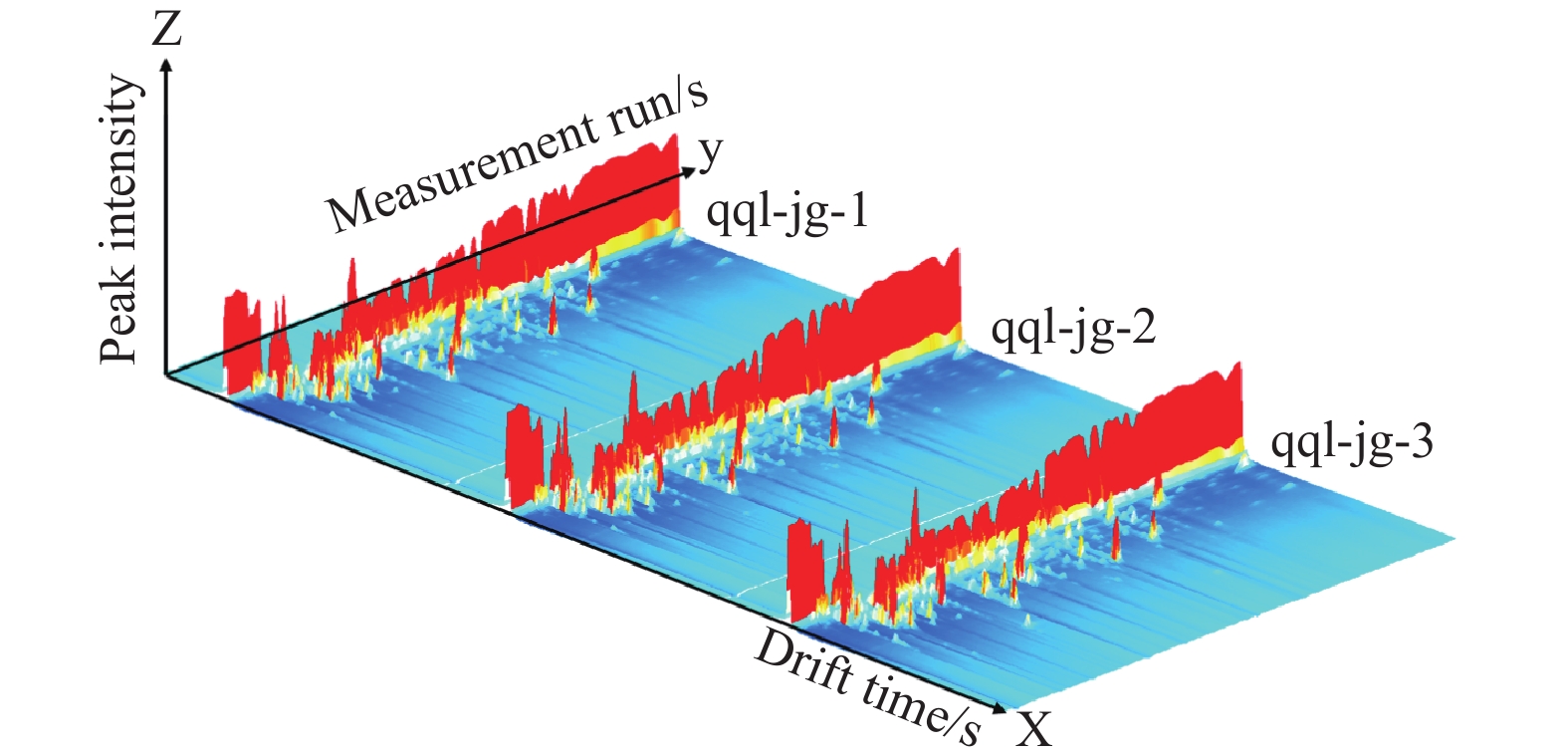
 下载:
下载:
